Bavaria 34
Acomfortable coastal cruiser designed for easy sailing
Unlike some production boats, most everything aboard the German-engineered Bavaria 34 is right where you need it. Take for example the throttle lever, which sensibly is mounted on the steering pedestal instead of tucked to one side or other of the cockpit. It seems a small detail, but any sailor who has had to maneuver a boat while leaning over the rail knows the inconvenience of having the throttle lever just out of reach because it's located behind the cockpit bench on the opposite side.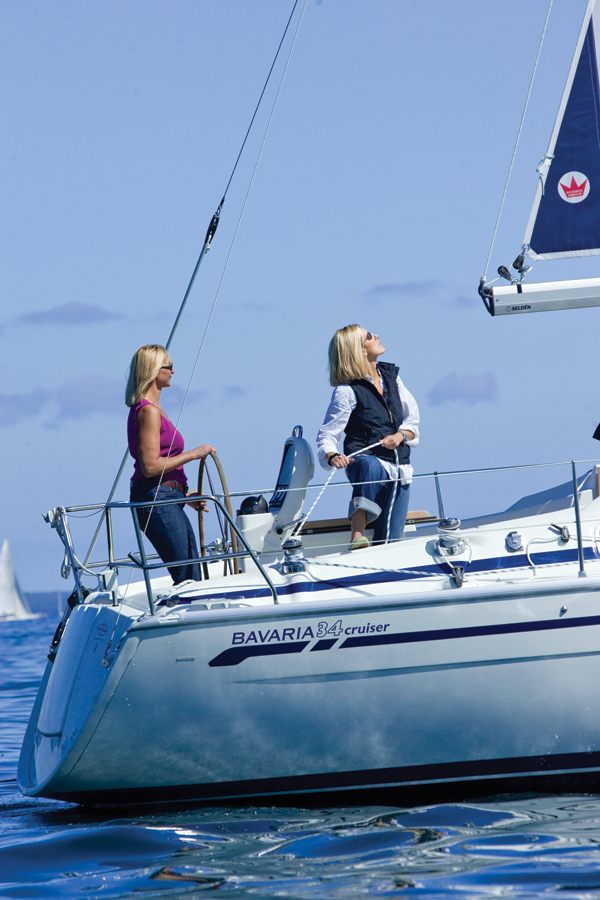
Same goes for the traveler. It's bolted atop the coachroof just forward of the companionway hatch, where it should be, and not across the cockpit benches where it interferes with other lines, the flow of crew and passengers, and is difficult to access.
The lone helmsman will also appreciate the boat's six winches since there's no need to cleat off a line in order to share the only winch on the coaming. The Bavaria 34 has a pair of self-tailing, two-speed genoa winches, two self-tailing secondary winches, and two self-tailing halyard winches. As a wise sailor once said, better to have them and not need them, than need them and not have them.
Again, in terms of convenience while underway, the design brings all key control lines back to the cockpit.
A series of rope clutches atop the cabin to either side of the companionway make for easy short-handed sailing.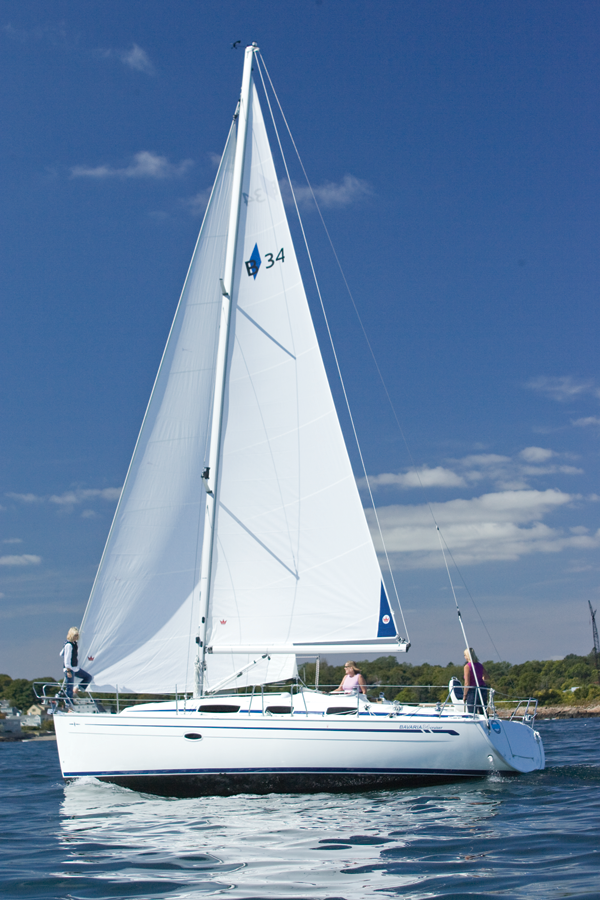
The fractional-rig sailplan is about as simple as it gets. The Selden mast, with a split backstay, supports two sets of swept-back spreaders. The helmsman can easily adjust the mast rake by cranking on or loosening the cam cleat controlling the running backstay. An in-mast furling system takes care of the main, while a Furlex roller-furling drum manages the headsail.
Although we were at a harbor mooring when we departed for a SAILING Magazine test sail out of Marblehead, Massachusetts, in late September, hauling up the anchor would have required little effort with the boat's hefty electric windlass and bow chain locker. The wind was light, but with a little coaxing the Bavaria 34 was soon tacking in the shadow of Marblehead Light and heading for Cat Island. As we picked up speed, one of the crew relaxed in the wooden seat bolted to the stainless steel bow pulpit.
Craig Sheard from Eastern Yacht Sails in Marblehead mustered the able crew of three women friends who showed us just how easy it is to sail the Bavaria 34. Clearly no big muscular guys were needed. When their inflatable dinghy approached, getting the crew aboard was merely a matter of pushing a button near the plumb stern to activate the electric swim platform that doubles as a transom when in the up position. Once deployed, the platform incorporates a stainless-steel boarding ladder that can be flipped into the water.
A nit-picking point, a button installed on the outside of the transom itself would have allowed the dinghy operator (or a passenger) to push it upon arrival. If nobody is aboard the boat, then there's nobody in a position to push the button.
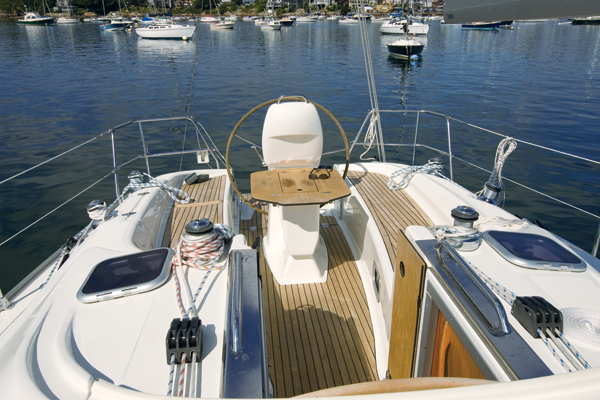
The dodger neatly tucks away into what amounts to a custom shell. The visibility from the helm is unobstructed. A pneumatic Selden boom vang provides additional control.
The compass is mounted on the pedestal and easy to read, as are the three gauges just forward of it. The entire arrangement takes up a significant amount of space in the cockpit, especially when the 36-inch-diameter steering wheel is added to the mix. A relatively large cockpit table compounds the space crunch. Reducing the overall scale of the pedestal and installing a folding wheel and slimmer table, providing it with a more collapsible design, could free up more space.
The Bavaria 34 is big on storage space-huge, in fact. The cockpit features a roomy, flip-up locker, ideal for stowing fenders, lines, boat hooks and other gear. Down below, lockers and cabinets are plentiful. Even the dinette settees feature hinged stowage compartments. While these amenities surely add to the boat's cost, they help maintain a clean interior architecture after the owner brings all necessary and personal gear aboard. 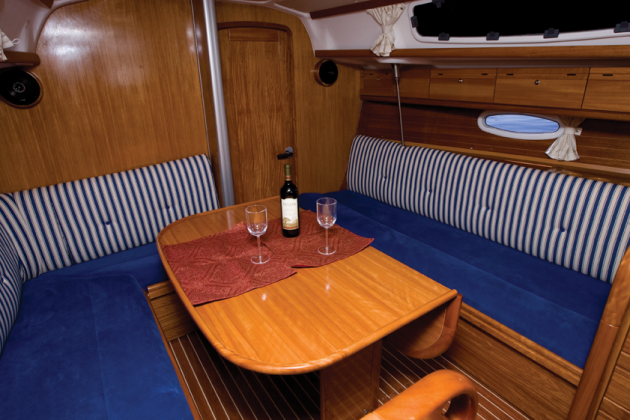
Boats without lockers look Spartan and pure at the boat show, but tend to require installation of hooks and mini-hammocks to accommodate the necessities of cruising. Under sail in a big sea, these items often seesaw until they tumble to the cabin sole. Lockers eliminate this dilemma.
Below decks
Down below, varnished mahogany bulkheads and doors warm the saloon, where a table with folding leaves dominates the space. The settee on the port side wraps around and butts against the forward bulkhead, creating an intimate space for dining. Standing up in the saloon shouldn't be a dilemma for most folks with 6 feet, 2 inches of headroom.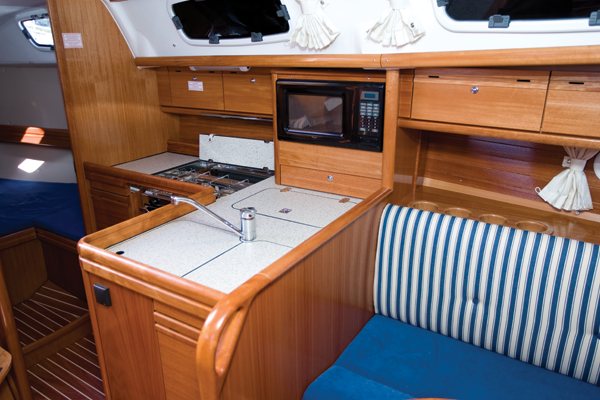
The functional galley is outfitted with a microwave, icebox and 12-volt refrigerator, gimbaled two-burner propane stove and oven and two-basin sink. At a glance, it appears a bit tight on prep counter space, but adequate to meet the needs of the average cruising family. The navigation station on the starboard side just at the bottom of the companionway features a bookshelf and drawer for charts and plotting tools. In addition to a series of gauges it incorporates an electronic illuminated panel showing a diagram of the boat with its running and anchor lights represented by colored bulbs. If there's a malfunction, one of these warning bulbs on the panel will light up, showing exactly where the trouble is located.
When it comes time to sleep, the V-berth accommodates two adults, as does the aft berth on the port side. The head, located aft and to starboard, is typical by production boat standards, with a sink, toilet and shower. 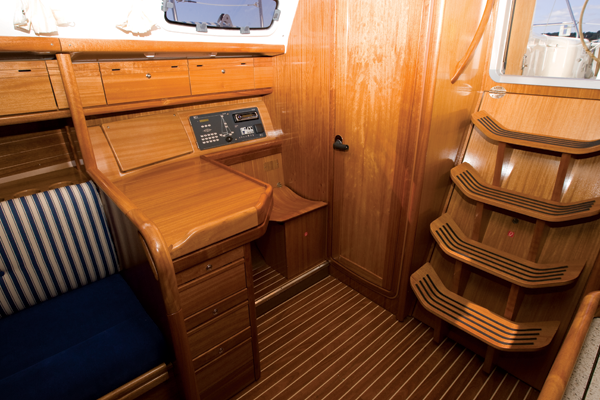
If nights are warm, the Bavaria 34 has enough ventilation via its deck hatches to keep the wind blowing through. During the day, the clear-view hatches allow light to penetrate and brighten the saloon, as do the portals.
The details
The Bavaria 34 is powered by a freshwater-cooled, Volvo Penta 28-horsepower diesel with saildrive. A flip-up companionway and other removable panels provide easy access to the engine.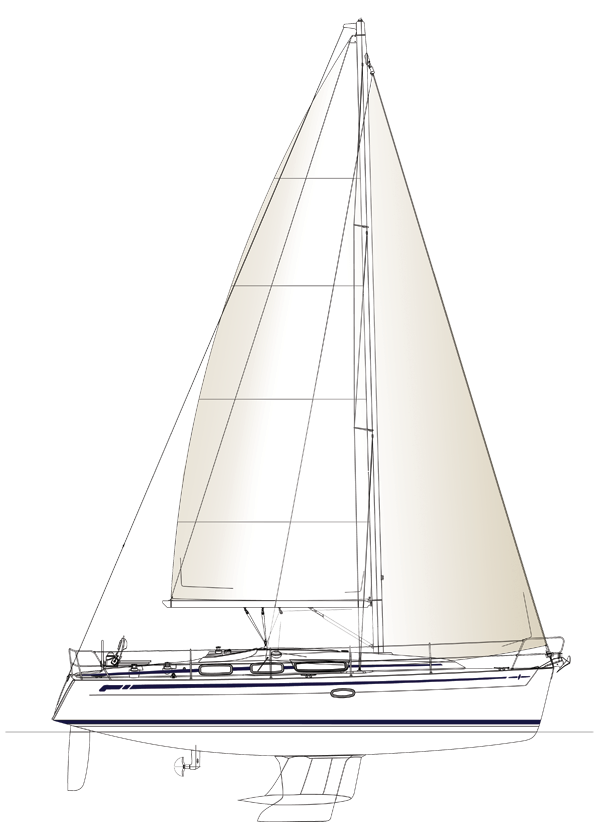
The boat's displacement is 12,540 pounds. The hull is hand-laid fiberglass, solid below the waterline. Some of the bow sections are reinforced with Kevlar. Buyers get a choice of two keels-the deep model at 6 feet, 4 inches and the shallow draft version at 5 feet, 1 inch. We tested the latter, getting close to the rocky shore around Marblehead Light with little fear of running aground. And at the end of our sail, the Bavaria 34 offers a no-muss, no-fuss arrangement as a result of the in-mast main and roller furling. By the time we reached the dock to let everyone off, the fenders were deployed, the lines readied, and boat prepped for return to her mooring-all within about five minutes. 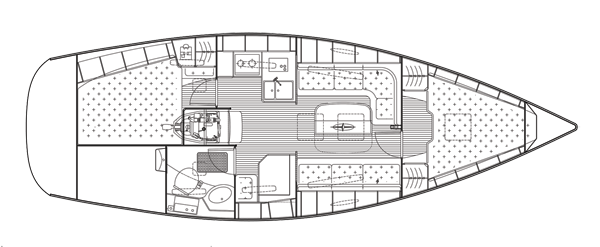
Interestingly enough, the Bavaria 34 is actually 35.2 feet long. With a beam of 11 feet, 10 inches, she's proportionately graceful, falling within the 3-to-1 ratio of length to width.
The boat carries 40 gallons of fuel and 55 gallons of water. It sells for between $150,000 and $165,000, depending on dealer preparation costs and options. 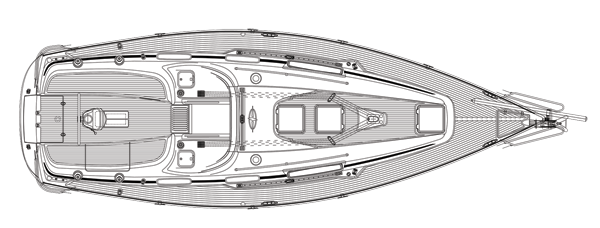

Comments